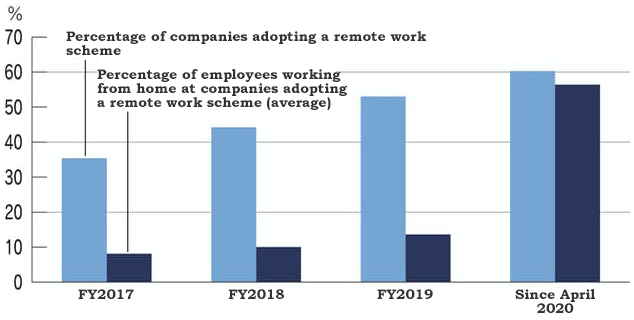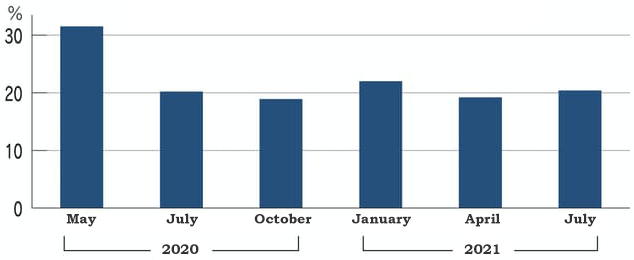Despite the progress in vaccination, the COVID-19 pandemic continues to rage on. Following the issuance of the fourth declaration of a state of emergency, the government has frequently called for companies to reduce the number of commuting workers by 70%, but there has been little progress in the effort to reduce the flow of commuters. Looking back at the pre-pandemic status of teleworking arrangements, including working from home, although large and listed firms were accelerating the teleworking schemes, the number of people actually working from home continued to be low.
Under the COVID-19 crisis, particularly since the issuance of the first declaration of a state of emergency in April 2020, the percentage of employees working from home (telework rate) has risen rapidly (see Figure 1). According to various surveys conducted since then, the telework rate declined temporarily after the state of emergency was lifted. However, under the subsequent declarations of a state of emergency, the telework rate did not show signs of rising (see Figure 2). What is the reason for this?


First, one major influencing factor is presumed to be the presence of differences between companies in the level of preparedness for teleworking before the COVID-19 crisis. In the case of companies which have been developing preparedness for teleworking since before the crisis and whose employees have experienced teleworking, it was probably easier to raise the teleworking rate under the crisis. On the other hand, in the case of companies which have not made sufficient preparations for such a change, it is easily conceivable that even if they tried to force employees to work from home, the attempt would fail due to an underdevelopment of the necessary infrastructure for working from home and a lack of experience.
Why were there such large differences between companies in the level of preparedness for teleworking before the COVID-19 crisis in the first place? What measures are effective in promoting teleworking under the COVID-19 crisis? How do the differences in the status of teleworking affect corporate earnings?
To answer those questions, I conducted a joint analysis with Gakushuin University Professor Miho Takizawa and Keio University Professor Isamu Yamamoto using the Nikkei Smart Work Management Survey (which covers more than 700 listed and unlisted companies) and published a report titled "Nikkei Smart Work Management Study Group Meeting 2021—Changes in the With-COVID-19 Era and Role of Health and Productivity Management" in July.
In this article, I will introduce the results of our analysis regarding how the status of teleworking, the operational situation, and workforce adjustments of companies under the COVID-19 crisis affect corporate earnings.
♦ ♦ ♦
First, we found that the teleworking rate (the percentage of employees working from home among regular employees) before the COVID-19 crisis (fiscal 2019) tended to be high at companies that met the following six conditions.
(1) Teleworking is allowed for any reason; (2) diverse and flexible working styles, including flexible working time and engaging in secondary jobs, are allowed; (3) there is a well-developed technical infrastructure, indicated by a high percentage of employees using mobile PCs provided by the company, full digitization of meeting reference materials and application documents, and the introduction of "free address" office space and "thin client" computers; (4) The working environment is favorable for taking holidays, indicated by a high number of holidays taken, a high ratio of employees who took five or more annual paid holidays during the study period, and the presence of many schemes to promote holiday-taking; (5) a large number of diversity-promotion measures have been taken; and (6) there is deep understanding and awareness among employees about measures related to working from home implemented by the company, or the company is striving to understand employees' needs, indicated by frequent implementation of employee surveys and employer-employee dialogues.
On the other hand, there is no significant correlation between the telework rate and the percentage of regular employees specialized in specific jobs or the weight of performance-linked wages.
We also found that under the COVID-19 crisis, the telework rate (since April 2020) tended to be high at companies that met the following conditions: (1) the telework rate before the COVID-19 crisis was high; (2) the development of preparedness for using information terminals is high, indicated by high ratios of employees using mobile PCs provided by the company, and temporary teleworking employees using terminals provided by the company; and (3) there are many measures to support teleworking (e.g., provision of displays and financial assistance for the purchase of displays).
Regarding the business performance of companies adopting teleworking under the COVID-19 crisis, we conducted an analysis using the questionnaire survey data for the operating rate on a man-hour basis (the number of employees multiplied by working hours) and the presence or absence of workforce adjustment as proxy variables for financial data for which recent data is not available.
These two indicators may also be regarded as benchmarks for resilience against the COVID-19 crisis, and our analysis showed that the operating rate tended to be high and workforce adjustment tended to be minimal at (1) companies that had a high telework rate before the COVID-19 crisis and (2) companies that were providing mobile PCs to large percentages of their workforce. In addition, there was a correlation between the presence/absence of workforce adjustment and the number of both physical and nonphysical teleworking-related problems recognized by the company.
What implications can be obtained from the above findings? First, in order to raise the telework rate under the COVID-19 crisis and, by extension, enhance their resilience against future crises, it is important for companies to make use of the kinds of technologies that help increase the efficiency and safety of teleworking and take other measures to develop a favorable environment for teleworking.
Second, as both telework rate and resilience of companies under the COVID-19 crisis depend also on the pre-crisis telework rate, tackling only the issues that emerged after the pandemic is insufficient.
Third, the gaps between companies in these respects before the COVID-19 crisis reflected differences in the degree of preparedness for using remote working technologies, as is the case under the crisis, but they were also related to how thoroughly digitalization was pursued, including a shift to paperless business operations, which is a prerequisite for teleworking. Regarding matters related to working styles, it is noteworthy that the telework rate is correlated with the adoption of "schemes that allow employees to be absent from the workplace," including flexible working time schemes, schemes which allow for engagement in secondary jobs, and schemes that encourage holiday-taking. Implementing simultaneous complementary measures may produce significant synergistic effects.
Moreover, companies that eagerly implement diversity promotion measures or that make efforts to enhance mutual understanding of employers and employees, that is, companies that place emphasis on increasing employees' well-being (state of being in good condition physically, mentally and socially) made more progress in promoting teleworking. On the other hand, we did not find a correlation between the telework rate and the introduction of job-specific employment or performance-based employee evaluation. Therefore, introducing those measures is not necessarily essential to promoting teleworking.
♦ ♦ ♦
Before the COVID-19 crisis, I noticed that among the companies participating in the Nikkei Smart Work Management Survey, almost all of those that were implementing working style reform and advanced personnel-related measures, including diversity promotion measures, also actively promoted working from home and other teleworking arrangements, and had systems in place which widely allowed employees to freely choose to work from home.
I have emphasized that whether a company promotes teleworking is the litmus test for determining the degree to which it is implementing and deepening personnel-related measures, and the above findings corroborate this point.
Companies that have not made progress in promoting teleworking must first make efforts to develop the environment directly necessary for teleworking, including preparedness for using remote working technologies. Next, we hope that the unprepared companies will start steady reform efforts with an eye to a post-COVID-19 world, based on the recognition that they were unable to effectively implement the measures that should have been in place since before the COVID-19 crisis, such as thoroughly pursuing digitalization, promoting diverse and flexible working styles that are not constrained by time or location, and prioritizing employee well-being within company operations.
* Translated by RIETI.
September 15, 2021 Nihon Keizai Shimbun


